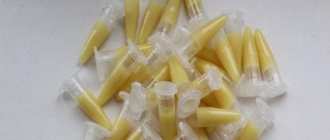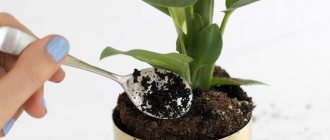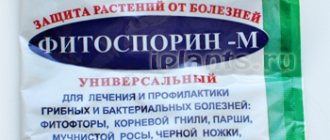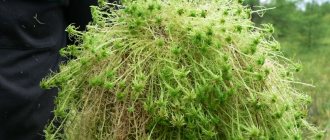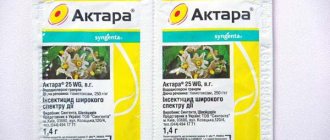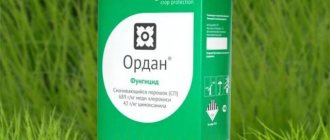Every summer resident has encountered late blight. This is a fungal disease that most often appears when there is a lack of sunlight and waterlogging of the soil. In dry and clear weather, its occurrence is less likely, although it cannot be completely excluded. It infects tomatoes and potatoes, cucumbers and eggplants, that is, almost all garden plants. There is an opinion that the disease must either be prevented or the bushes destroyed to prevent the development of a fungal infection. And today we are considering an effective remedy that can be bought at a regular pharmacy. Summer residents have been using Trichopolum for plants for decades. Use in such an unconventional manner was made possible due to the unique properties of the drug.
Ways to prevent the disease
It is easier to prevent any illness than to treat it. This also applies to late blight. There are a number of measures that can help avoid its occurrence:
- The earlier in the spring you plant plants in the ground, the less chance they will be damaged. This also applies to tall varieties; they are also more resistant.
- Place the beds in ventilated areas. In this case, the bushes must be placed in such a way that the leaves do not touch each other. It is recommended to trim the lower branches.
- It is advisable to water plants exclusively at the roots.
- Be sure to tie up lush tomato bushes and cucumber vines. Contact with soil increases the likelihood of developing the disease.
Traditional methods
The salvation from late blight is not only the use of Trichopolum for plants. We will return to it now, but for now let’s talk about what other methods summer residents have.
- Garlic solution is practically free. To do this, add 200 g of garlic to a bucket of water. It must be thoroughly crushed and filled with water. For better adhesion of the solution, soap is added.
- Bordeaux mixture. If it rains every day, then garlic is already powerless. You need a tool that will help 100%. 8 liters of water are poured into an enamel bucket and 100 g of vitriol are added. Separately, 130 g of lime is slaked in a liter of water. Mix these two solutions and start treating the plants.
Each of these methods has disadvantages. In the first case, rain completely washes the composition off the leaves, and in the second, strong poison has to be used. The use of Trichopolum for plants is an excellent alternative. This is a safe and reliable way to protect your garden from fungal diseases.
How can you enhance the effect of the drug?
To prevent pathogenic microorganisms from becoming accustomed to the components of the drug, Trichopolum treatments are alternated with spraying with other means. Summer residents praise milk-iodine compositions, as well as garlic infusions.
- a liter of whey is poured into a bucket, topped up to full volume with water (9 liters), 25 drops of iodine are added, and the plantings are sprayed onto the leaves;
- A liter of sour kefir is poured into a bucket of warm water and mixed. Then add 50-80 grams of chopped garlic and mix again. Leave for 30 minutes and process tomatoes, cucumbers, and eggplants;
- dilute yeast (raw) in a bucket of water, 100 grams per 10-liter volume, leave for 2-3 hours;
- mullein (1/4 kg) is diluted in 5-6 liters of water, left for a day. Spray tomatoes and cucumbers 3-4 times per season.
Such compositions are recommended for both prevention and treatment of crops in the initial stages of the disease.
The effect of solutions with Trichopolum is enhanced by the addition of iodine, brilliant green, and potassium permanganate.
- add a bottle of iodine to the standard composition with Trichopolum (20 tablets per 10 liters of warm water);
- Exactly the same scheme, only instead of iodine they pour in a bottle of brilliant green.
Both solutions are prepared immediately before use, treating tomatoes and cucumbers completely in all tiers. Particular attention is paid to soaking the underside of the leaf blades with the composition.
Universal remedy
Today there are no problems with this. In specialized stores there is a huge selection of drugs that provide a good therapeutic effect. But gardeners are stopped by two points: price and components. Nobody wants to treat ripening tomatoes with chemicals, because soon they will need to be used to prepare healthy salads. The use of Trichopolum for plants makes it possible to carry out completely harmless preventive treatment of plantings. Moreover, the cost of the procedure is quite small.
Seven troubles - one answer
You can purchase the drug at a pharmacy, where it is sold without a doctor's prescription. The use of Trichopolum for spraying plants gives a positive result on cucumbers and tomatoes, as well as on any garden crops. There are a number of diseases for which this simple drug is a salvation:
- The first and main thing is late blight. The widespread scourge is destructive for all types of crops. Every summer resident knows how it manifests itself. Brown spots appear on the surface of the leaves. The cause is a fungus that spreads through spores. It is enough for it to appear in your neighbors’ garden, and under favorable weather conditions, your garden will also be under threat.
- The use of Trichopolum for plants in the country is also justified for the treatment of powdery mildew. Most often it affects cucumbers. The disease spreads very quickly, almost instantly. The leaf begins to turn yellow and fade, and a white coating appears on it. As a result, even if the plant does not die, the yield will deteriorate sharply.
- Another disease that this drug can help with is fusarium. The disease contributes to the formation of rot on plants and yellowing of leaves.
- Corner spot is another dangerous fungal disease. Most often it affects cucumbers. All leaves begin to dry out and die. Fruiting is reduced to a minimum.
The use of "Trichopol" for plants in case of illness
Relatively recently, they began to use metronidazole in the garden and country house. But the results convinced everyone that this is a reliable and budget-friendly remedy. Thanks to the advantages that this drug has, plant treatment becomes more effective. Just three or four treatments per season are enough to prevent late blight from causing much harm to plants. Gardeners report several major benefits. This is safety for humans. The fruits can be safely eaten only after rinsing them with water. The second positive point was also identified experimentally. It has an effective effect not only on fungi and pathogenic bacteria, but also on pests. They avoid plants treated with metronidazole.
How to treat tomatoes with Metronidazole
You can treat tomatoes with the drug at the stage of sowing seeds - this will protect the seedlings not only from late blight, but also other fungal diseases. To do this, the seeds are soaked in the prepared solution for 30 minutes, then they are dried and planted in a planting box.
Step-by-step instruction
The drug is most often used for spraying:
- Prepare the solution.
- Spraying is carried out in the first half of a dry, windless day.
- For the procedure, a fine spray is used.
- Process the stem and leaves on both sides, paying special attention to the lower branches.
- Additionally, water the seedlings at the root with the solution - 50 ml per bush.
- If precipitation occurs after spraying, the procedure must be repeated.
Important! When working with metronidazole, you must use personal protective equipment - a mask and gloves. It is not recommended to stay in the greenhouse for a long time after treatment.
Processing times and frequency
Spraying with Metronidazole is carried out no more than 3 times a season:
- the first spraying after planting seedlings in the garden bed;
- the procedure is repeated 2 weeks before the start of harvest;
- if there are no signs of disease, then there is no need for treatment.
Gardeners do not recommend using the drug to treat tomatoes 2 weeks before harvest . Despite the fact that the hazard class for humans of the drug has not been established, to protect health it is better not to shorten the waiting period.
First treatments
The use of Trichopolum for plant treatment should be done in advance. If signs of the disease are already visible to the naked eye, then it may be too late. Based on experience and numerous experiments, gardeners have developed the ideal schedule that will help protect your plantings. Do not forget that the disease spreads very quickly, so you should not delay treatment. Carry out preventive treatments on time:
- The first is when sowing seeds. There are two options: soak the seeds in the solution or spill the soil immediately after planting them.
- The second is during picking seedlings.
- The third is when transplanting into open ground or a greenhouse.
Such measures do not allow the insidious fungus to settle on plants and prevent the spread of its population.
Summer treatments
Now it’s clear why Trichopolum is used for plants. The use of an antimicrobial drug is not limited to treatments in the initial phases of growth. It is necessary to spray throughout the season. The first treatment is carried out in early summer. During this period, ideal conditions are created for the proliferation of fungal infections on tomato bushes. However, if late blight appears primarily on tomatoes, you should not think that the rest of the plants are safe. Metronidazole is excellent for cucumbers and beans, cabbage and grapes, as well as for fruit trees.
Recipe for preparing the solution
In the garden, the drug is used in the form of a working solution, which is used to spray the affected parts of plants or all plantings for preventive purposes.
How to prepare and dilute a standard spray composition:
- a package of tablets (20 pieces) is crushed into powder, poured into a jar of water (0.5 liters), stirred gently;
- pour the contents into a bucket and add warm water to a full volume of 10 liters;
- mix well;
- insist for 20-30 minutes.
The prepared solution is poured into the spray tank and the plantings are treated.
Attention! The working solution is prepared before use, calculating the exact volume and flow rate. It is not recommended to store the composition.
The dosage of solutions for soaking seeds, watering seedlings, and adult plants will be less: 10 tablets (half a pack of Trichopolum) are diluted per 10 liters.
Second treatment
Inspect your plantings regularly. If you see traces of rot, then you need to spray without delay. Now the treatment should be repeated regularly, every day, until the symptoms of the disease disappear. Additionally, you will need to carry out root watering with a solution of Trichopolum. If the planting condition is normal, then the second treatment is carried out before the start of harvesting. It is best to do it two weeks before mass fruit harvesting. But cucumbers and tomatoes collected even immediately after processing are not hazardous to health.
Some gardeners recommend a different treatment regimen, that is, once every ten days, throughout the season. But in this case, the fungus may adapt to the drug, so you will have to change the recipe regularly.
What kind of drug is this
Metronidazole is an antibacterial drug used to treat many diseases . However, this remedy has also found use in the garden due to its pronounced antifungal properties.
The principle of action in the fight against late blight
The drug contains the active ingredient metronidazole . Coming into contact with late blight, it actively affects the DNA of the pathogen cell, slows down protein synthesis and the formation of nucleic acids, which leads to the cessation of fungal reproduction.
Differences from "Trichopol"
The drug "Trichopol" is an analogue of "Metronidazole" , there are no special differences between them. It is also based on the active ingredient metronidazole. The dosage in these two drugs is also identical - 250 mg.
“Trichopol” is the trade name of the drug, and “Metronidazole” is the international nonproprietary name. In fact, these are the same medicine, just under different names. There is no difference in which tablets to use in the garden.
Efficiency
Metronidazole destroys pathogenic fungi and bacteria ; it is equally effective against most known strains. Keep in mind that fungal microorganisms have the ability to quickly adapt to drugs, so you cannot use the product regularly.
Important! The drug is a medicinal drug - it has contraindications and dosage.
Metronidazole is used in the treatment of the following diseases:
Pros and cons of using
Like any other drug, Metronidazole has a number of its strengths and weaknesses .
Advantages of the drug:
- high efficiency;
- affordable price;
- ease of use;
- absence of pesticides.
Disadvantages of Metronidazole:
- the drug is not officially included in the list of products for the treatment of agricultural crops;
- promotes the development of pathogen resistance;
- the need for replacement or search for combinations with other means;
- the effect of the substance on plants has not been studied;
- the hazard class for humans has not been established.
Dosage
How to dilute Trichopolum for plants? Instructions for use recommend the following proportions. You will need to dilute 20 tablets in 10 liters of water. The tablets must be thoroughly crushed and diluted in a small amount of water, and then mixed with the rest of the liquid. After 20 minutes you can start processing garden plants. For small areas use a sprayer. But if the area is large, then it is necessary to use a sprayer.
Potassium permanganate, or more simply – potassium permanganate
Manganese, which is part of potassium permanganate as a microelement, is very important in the life of plants. Despite the negligible doses, it helps improve growth, enhance the immune system of plants, and strengthen the root system. If you water plants with a light pink solution of potassium permanganate, this will not only provide them with the necessary element, but will also disinfect the soil from fungi and bacteria. In addition, the solution is harmful to root scale insects, various caterpillars and beetles.
A light pink solution is used to prevent the infestation of aphids, mites and whiteflies. Potassium permanganate crystals can cause burns to plants. Therefore, it is recommended to make a stock solution of the drug in a small, approximately 0.5 l, bottle. If necessary, add a little mother liquor to the water.
Zelenka and Trichopolum
You can significantly improve the result if you add an additional ingredient to the composition. The combination of brilliant green and metronidazole gives excellent results. An antifungal drug can remove all pathogens of the disease, and brilliant green will cure tomatoes from infection. By mixing these medicines, you get an environmentally friendly and effective remedy. An alternative option is iodine.
To prepare the solution you need to mix 15 tablets with a bottle of iodine or brilliant green and mix with a bucket of water. Let us remind you once again that disinfection must be carried out before signs of the disease become obvious. For ease of spraying, a spray bottle is used. You can spray the plant with a small broom, which is not very convenient or economical.
Treatment of diseased tomatoes
Treatment of tomatoes with metronidazole against late blight is carried out using a foliar method. To properly prepare the solution, purchase 2 blisters of Trichopolum or an available analogue at the pharmacy. Dissolve in 1 bucket of water. First, prepare a concentrated solution. Then pour it into 10 liters of water, obtaining the optimal concentration.
When irrigating, it is important to consider that fungi are hidden as much as possible on the lower surface of the plates. Spraying is carried out especially carefully from below. To neutralize the roots, you need to water and treat the bushes well. The dose of solution per plant that can be sprayed is about 50 ml.
Treatment of tomatoes against late blight in open ground with Trichopolum is carried out once every 10-12 days. At the same time spray with additional means.
A similar procedure in the greenhouse is carried out 2 times for the purpose of prevention:
- 10-14 days after transplanting to the beds;
- on the eve of harvest.
To combat the pathogen at the height of the disease, irrigation is carried out daily or every other day until the signs of pathology disappear. Does Trichopolum kill late blight on tomatoes? The drug acts on the principle of fungicides, stopping dangerous infections.
According to reviews and results, the drug:
- completely justifies itself;
- effective in the initial stages;
- the disease stops quickly.
Many gardeners prefer the drug because of its harmlessness and non-toxicity.
Price
The use of Trichopolum for indoor plants is also justified. In parallel with cultivating the garden, you can regularly spray decorative flowers. This will not cause any harm, but it can prevent a number of problems. According to gardeners, the use of this medicine allows you to do without pesticides. The drug can be easily purchased in city pharmacies or ordered online.
The cost of Trichopolum is 90 rubles per package. This is the price of one treatment, provided that one bucket is enough for you. Treating a large garden will cost much more, so an analogue called metronidazole is more often used. Its price is about 10 rubles per package. At the same time, the composition is almost the same, and the price does not affect the quality. It doesn't matter which drug you buy.
